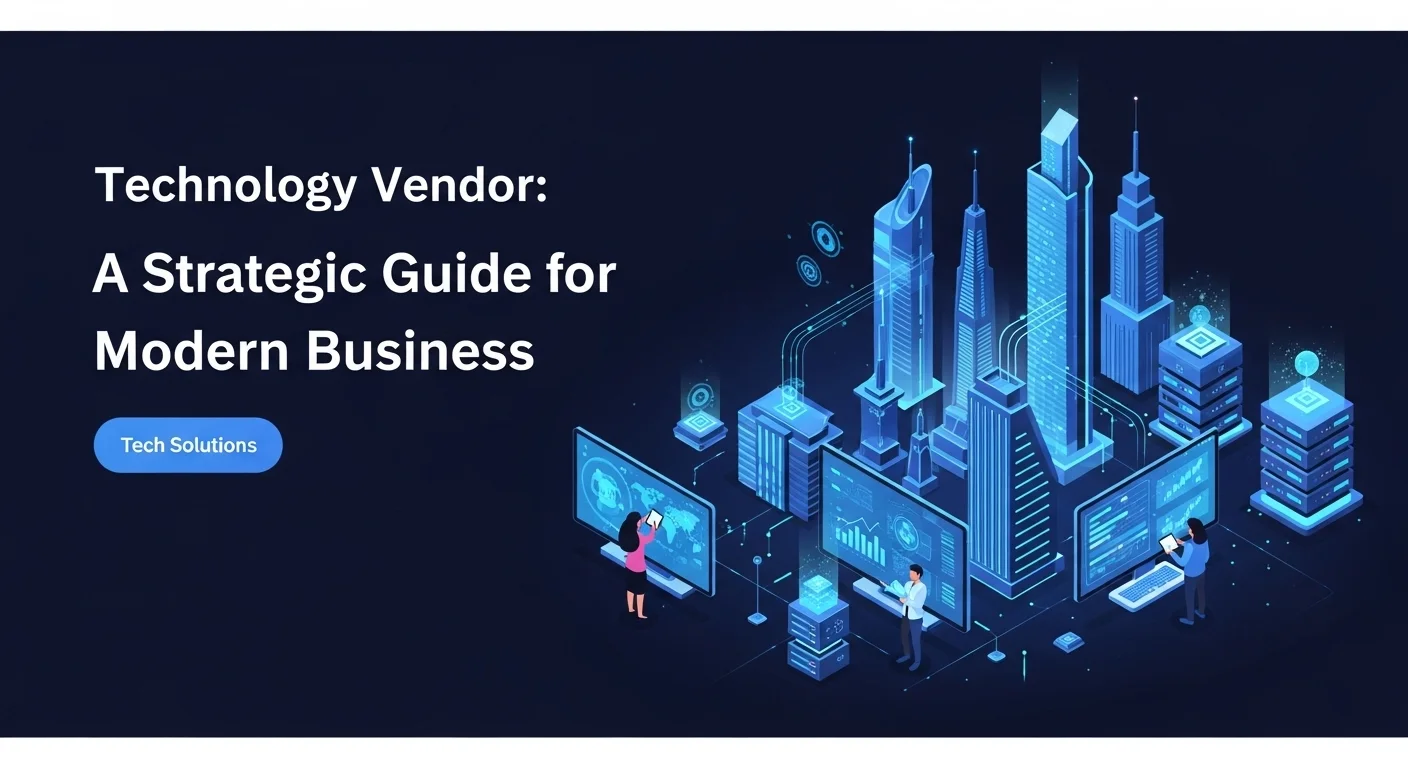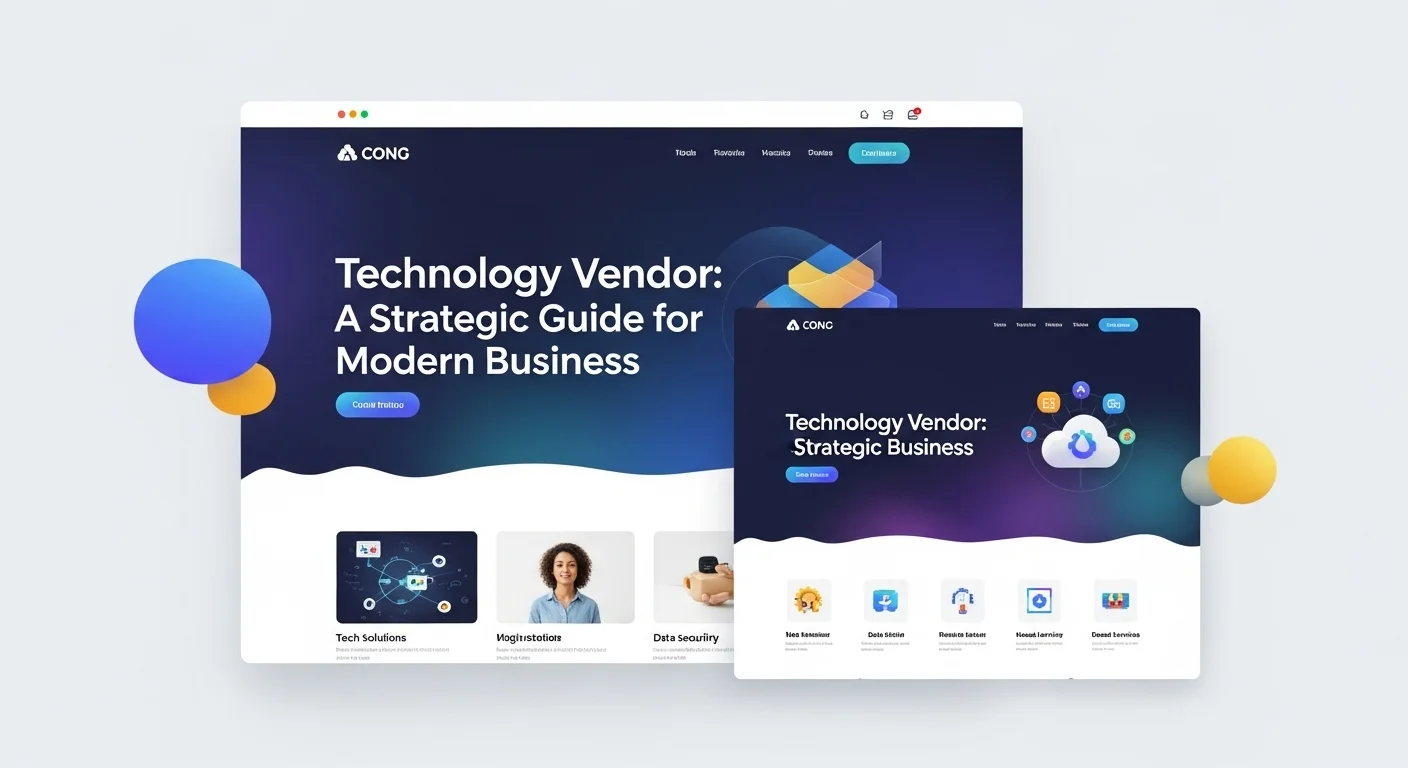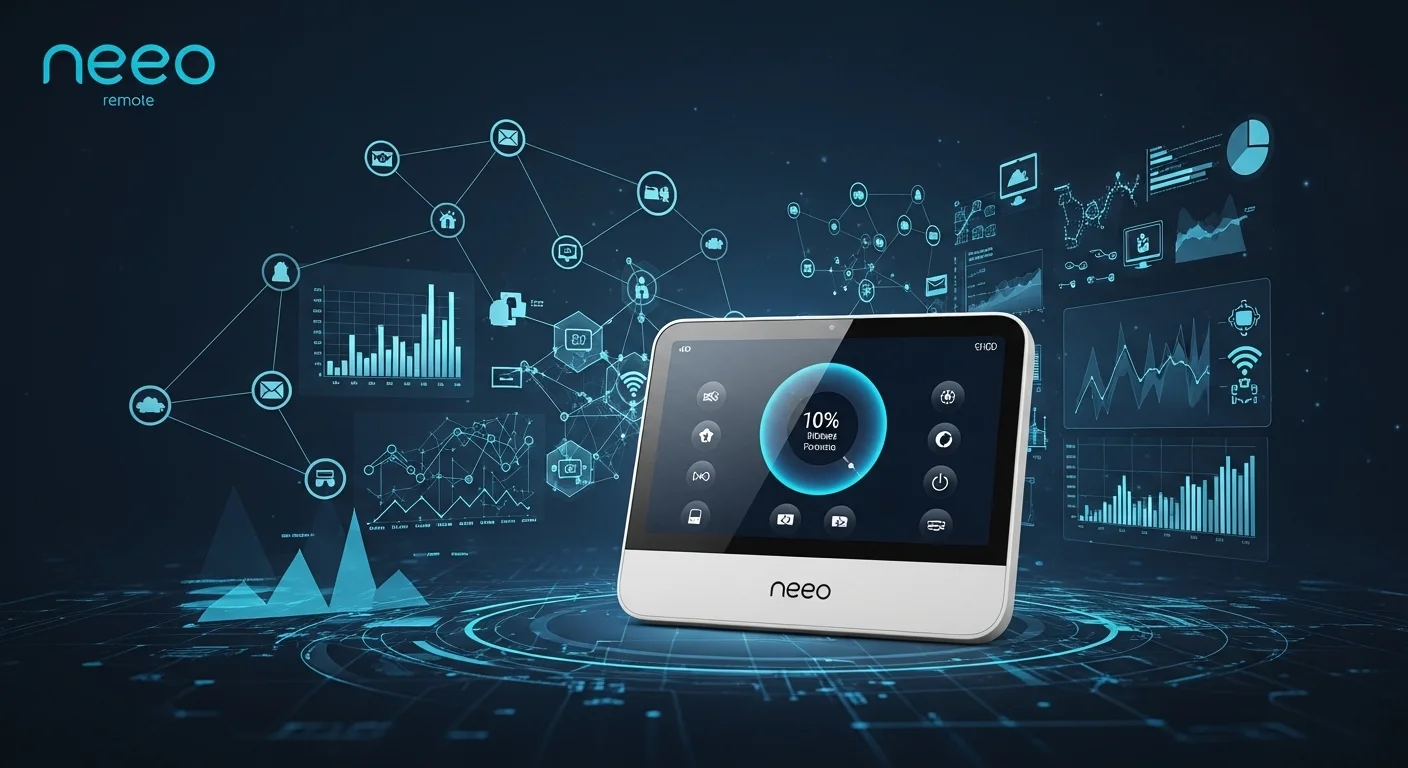Your Guide to Choosing the Right Tech Vendor: A Strategic Partnership

Executive Summary
In my 20 years in the IT world, I've seen one fundamental shift change the game for businesses of all sizes: treating technology vendors not as simple suppliers, but as core strategic partners. It's no longer about just buying a piece of software or some hardware. Today, we're weaving complex services and tools into the very fabric of our operations. This article is my comprehensive guide to the world of technology vendors, built from years of experience. I'll walk you through what they are, the different types you'll encounter—from hardware giants to specialized cybersecurity experts—and the crucial steps for choosing, managing, and evaluating them. Forging strong, secure partnerships isn't just an IT task anymore; it's a vital business skill that boosts efficiency, reduces risk, and gives you a serious competitive edge. Let's dive in and make sure every vendor relationship you build adds real, tangible value to your long-term goals.
Table of Contents
What Exactly Is a Tech Vendor, and Why Should You Care?
In the simplest terms, a technology vendor is any company or individual that sells you tech-related goods or services. But honestly, that definition barely scratches the surface. Think of them as the companies that build the foundation of your entire digital operation. These aren't just faceless suppliers anymore; they're integral partners whose performance can directly impact your innovation, your security, and your bottom line. I remember back in the day, a vendor relationship was purely transactional—you'd buy a server or a box of software, and that was that. Today, that relationship is a continuous, strategic partnership. We rely on a whole network of external experts for everything from our cloud infrastructure and SaaS tools to our cybersecurity defenses. This deep integration is why managing these vendors effectively has become one of the most critical skills for any business that wants to stay competitive, control costs, and keep operations running smoothly.
So why are they so important? First, they give you access to incredible expertise and technology that would be ridiculously expensive and time-consuming to build yourself. Imagine trying to create your own CRM with the power of Salesforce or building a global network of data centers like Amazon Web Services. By partnering with vendors, you get world-class tech without the massive upfront investment. Second, they allow you to scale. As your business grows, a good vendor grows with you. A startup can begin with a small cloud plan and expand its resources as needed, paying only for what it uses. That flexibility is the heart of modern business agility. Third, they push you to innovate. The tech market is fiercely competitive, so vendors are constantly improving their offerings. By choosing the right partners, you get to ride that wave of innovation without having to do all the heavy lifting yourself.
The Diverse World of Technology Vendors
Not all vendors are created equal. The tech world is a rich ecosystem of different specialists, and knowing who does what is the first step to building a smart tech strategy. Here’s a breakdown of the main players you'll encounter:
- Hardware Vendors: These are the folks who make the physical gear. Think Dell or HP for servers and computers, or Cisco for the networking equipment that connects everything. Even with the massive shift to the cloud, these vendors are still essential for data centers, office setups, and the growing army of Internet of Things (IoT) devices.
- Software Vendors: This category is huge. It covers everything from operating systems like Microsoft Windows, creative tools like the Adobe suite, and countless specialized business applications. More and more, we see software delivered as a subscription (SaaS), which has totally changed how we buy and use it. This group also includes Independent Software Vendors (ISVs) who create niche software for specific platforms.
- Cloud Service Providers (CSPs): The giants here are Amazon Web Services (AWS), Microsoft Azure, and Google Cloud Platform (GCP). They provide the fundamental building blocks of modern IT, like computing power (IaaS) and development environments (PaaS). They're so foundational that many other software vendors actually build their products on top of these cloud platforms.
- Telecommunications Vendors: These are the companies that provide the internet and network connections that tie all your technology together. From your office ISP to providers of dedicated fiber lines, they are the digital world's lifeline.
- Security Vendors: As cyber threats have grown more complex, this field has exploded. It's a highly specialized area with its own cast of characters. For example, network security vendors like Palo Alto Networks focus on protecting your network perimeter with firewalls and threat detection. Then you have cloud security vendors like Zscaler or CrowdStrike, who specialize in protecting your data and apps in the cloud. A really critical and growing niche is OT security vendors (Operational Technology), like Siemens or Honeywell. They focus on securing the industrial systems in places like factories and power grids, where a cyberattack could have physical consequences. You'll often hear the term OT cybersecurity vendors to highlight the specific digital protection needed for these sensitive environments. This variety proves a crucial point: no single vendor can protect you from everything. You need to build a team of security partners to create a strong defense.
Why You Can't Skip the Vendor Security Check
When you bring a vendor into your operations, you're also bringing in their security risks. It's a stark reality I've seen play out many times: a data breach that cripples a company often starts with a vulnerability in one of its third-party vendors. This is why a vendor cybersecurity assessment is one of the most important things you will ever do. It’s a deep dive into a vendor's security practices to make sure they're strong enough to protect your business. This isn't just a one-time check before you sign a contract; it's an ongoing process that lasts the entire life of your partnership. The assessment forces you to ask the tough questions: How do you protect our data? What are your security policies? Are you compliant with regulations like GDPR? What's your plan if you get hacked? This due diligence is vital for every vendor, but it's absolutely non-negotiable for anyone handling sensitive data, like the cloud security vendors you trust, or the OT security vendors protecting your factory floor. A thorough assessment lets you make smart decisions, demand stronger security clauses in your contracts, and ultimately build a more resilient business. It involves checking their documents, sending detailed questionnaires, and sometimes even running tests to verify their defenses. It’s this proactive stance, especially when engaging with specialized network security vendors and OT cybersecurity vendors, that separates the prepared from the vulnerable.

A Complete Guide to Managing Tech Vendors and Business Solutions
Getting vendor relationships right isn't magic; it's a structured process. I've found that moving from identifying a need to building a successful partnership follows a clear path. This guide is my walkthrough of that lifecycle, from picking the right partner to managing them for the long haul, with a heavy emphasis on the security checks that are essential today. If you master this process, you'll unlock the true value of your vendors and ensure they're helping you hit your goals.
Step 1: The Selection Process – Looking Beyond the Sales Pitch
Everything starts with knowing what you need. Before you even think about looking at vendors, you have to define what a successful outcome looks like for you. What problem are you solving? What are your must-have technical features, your budget, and your business goals? This internal homework becomes the foundation for your Request for Proposal (RFP), the document you'll use to get formal proposals from potential partners.
Once you know what you're looking for, you can start identifying potential vendors. I recommend a mix of market research, asking peers for recommendations, and reading analyst reports from firms like Gartner. When you have a shortlist, it's time to dig deeper than the slick marketing brochures. Look into their history, financial health, and what their current customers are saying.
Now for the most critical step: the due diligence, where the vendor cybersecurity assessment takes center stage. I can't stress this enough—this isn't a simple checklist. It's a thorough investigation to confirm the vendor can actually protect your data. You'll need to tailor your questions based on the vendor type and the risk they pose. For instance, the questions for potential cloud security vendors will be very different from those for a hardware supplier. Here are the key areas I always investigate:
- Security Leadership & Governance: Who's in charge of security at their company? Do they have a formal security program based on a recognized framework like NIST or ISO 27001? Don't be shy about asking to see their security policies.
- Data Protection & Privacy: How will they handle and protect your data? What kind of encryption do they use? How do they ensure they meet privacy rules like GDPR? This is critical if they'll be handling any personal customer information.
- Access Controls: How do they manage who gets access to what? Do they require multi-factor authentication (MFA)? How are admin accounts controlled to prevent misuse?
- Incident Response & Continuity: Do they have a plan for when things go wrong? Have they tested it? How will they notify you if there's a breach involving your data? Can they recover quickly from a disaster to keep your service running?
- People Security: What are their hiring standards? Do employees with access to your data get background checks and regular security training?
For specialized fields, you need to go even deeper. When you're evaluating OT security vendors, for instance, you have to verify they understand industrial systems and the very real physical safety risks of a cyberattack in a factory. Their job is to prevent digital threats from causing physical harm. Likewise, when assessing network security vendors, you need to look at how their equipment performs under pressure and how well it integrates with your other security tools.
Step 2: The Handshake – Crafting a Contract That Protects You
Once you've picked your partner, it's time to make it official with a contract. This legal document is your best tool for setting expectations and ensuring accountability. It needs to be reviewed by both your legal and technical teams. Never treat it as a standard template. Key things to negotiate are:
- Scope of Work: Be crystal clear about what they are delivering. Any ambiguity here is a recipe for future arguments.
- Service Level Agreements (SLAs): This is one of the most important parts. SLAs are measurable promises about the quality of service. For a cloud provider, it might be a 99.99% uptime guarantee. For support, it might be a 1-hour response time for critical issues. Always tie penalties or service credits to these promises if they're not met.
- Security & Compliance Clauses: Everything you learned in your vendor cybersecurity assessment should be reflected in the contract. It must state the vendor's security duties, data protection rules, and what happens in case of a breach. You should also have the right to audit their security controls.
- Data Ownership & Exit Plan: The contract must state that you own your data, period. It also needs to outline an exit strategy: how do you get your data back if you decide to leave? This is crucial to avoid being locked in with a vendor you're unhappy with.
Step 3: The Partnership – It’s a Marathon, Not a Sprint
The work isn't over when the ink is dry. A great vendor relationship needs constant attention and collaboration. This is what we call Vendor Relationship Management (VRM), and it's all about getting the most value out of your partners. Here’s what it looks like in practice:
- Performance Monitoring: Keep a close eye on how the vendor is performing against their SLAs. Use scorecards to keep it objective. This helps you spot problems early and hold them accountable.
- Regular Communication: Set up a regular rhythm for communication, from weekly check-ins to strategic quarterly reviews. This builds a real partnership, not just a transaction.
- Ongoing Risk Management: Threats are always evolving, so you need to re-assess your vendors' security from time to time. This could mean annual questionnaires or using monitoring tools to detect new risks. This ongoing vigilance is especially important for your critical cloud security vendors and OT security vendors, where a failure could be disastrous.
- Change Management: When your vendor updates their service, you need a process to understand the impact on your business and ensure a smooth rollout.
By following a solid framework for selection, contracting, and management, you can build an ecosystem of partners that drives your business forward securely and effectively. This structured approach ensures every vendor, from your firewall provider to the specialized OT cybersecurity vendors protecting your most valuable assets, is a true partner in your success.

Tips and Strategies to Improve Your Technology Vendor Experience
From my experience, successfully managing technology vendors is part art, part science. It's a mix of having solid processes, the right tools, and a genuinely collaborative attitude. When you shift from a reactive, 'just-a-supplier' relationship to a proactive, strategic partnership, you unlock incredible value—better service, tighter security, and more innovation. Here are my go-to tips, essential tools, and best practices to help you optimize your vendor strategy.
My Go-To Rules for Building Real Vendor Partnerships
The biggest change you can make is in your mindset. Start seeing vendors as an extension of your team, and you're already halfway there. Here’s how to foster that kind of relationship:
Align Their Goals with Your Goals: Before you even talk to a vendor, know exactly what business problem you expect them to solve. Then, share that vision with them. A true partner gets more invested when they understand *why* you need something, not just *what* you need. This is especially important for security partners. For example, when choosing from a list of cloud security vendors, explain your overall cloud strategy so they can recommend what truly fits.
Prioritize Value, Not Just Price: I've seen it time and time again: the cheapest option is rarely the best deal in the long run. A vendor that costs a bit more but offers fantastic support, stronger security, and better SLAs will almost always save you money down the road. The cost of downtime, a security breach, or poor performance dwarfs that initial price difference.
Foster Open and Honest Communication: Set up regular meetings, from weekly operational calls to quarterly strategy sessions with their leadership. Create an atmosphere where both sides feel comfortable bringing up problems and working together on solutions. The contract shouldn't be the only reason you talk to each other.
Embrace a 'Trust but Verify' Security Model: Building a great relationship is key, but it doesn't mean you can skip security oversight. This is where the continuous vendor cybersecurity assessment comes in. Trust that your vendor is doing the right thing, but verify it with regular check-ins, audits, and by reviewing their compliance reports. This applies to everyone, from your main software provider to your specialized OT security vendors.
Plan Your Exit Strategy Together: It might sound strange when you're just starting a partnership, but planning for the end is a sign of a mature relationship. A clear, agreed-upon exit plan ensures a smooth transition if you ever need to switch vendors, preventing data loss and operational chaos. It should detail how data will be handed back and how knowledge will be transferred.
Tools of the Trade: Software That Makes Vendor Management Easier
Trying to manage dozens of vendors with spreadsheets and emails is a recipe for disaster. It's inefficient and easy to make mistakes. The right technology can streamline everything and give you much better control.
- Vendor Management Systems (VMS): Think of this as a central dashboard for all your vendor information. A good VMS stores contracts, tracks performance against SLAs, manages communications, and automates onboarding. It’s your single source of truth.
- Governance, Risk, and Compliance (GRC) Tools: These platforms are your best friend for managing the security side of vendor relationships. They can automate security questionnaires, track fixes, and keep an audit trail for regulators. This is the engine that powers an efficient vendor cybersecurity assessment program.
- Security Ratings Services: Companies like SecurityScorecard and Bitsight offer objective, data-driven scores of a vendor's security posture. They constantly monitor for risks like malware or insecure systems, giving you an early warning of potential trouble.
- Contract Lifecycle Management (CLM) Software: These tools automate the entire contract process, from creation to renewal. They can send you alerts for key dates, so you never miss a renewal deadline and have time to renegotiate better terms.
A Real-World Story: The Factory That Got It Right (The Second Time)
I once worked with a mid-sized manufacturing company that was digitizing its factory floor. This was a complex project involving both IT and OT (Operational Technology) systems. They needed several partners: a major cloud provider, a couple of network security vendors for their new converged network, and a specialist from the pool of OT cybersecurity vendors to protect the industrial machines themselves.
At first, the procurement team focused only on price. Big mistake. Within six months, the problems started. The cheap network solution was slow and disrupted production. The OT security platform was a nightmare to integrate. Then, a minor security incident happened, and it took days to get a straight answer from anyone because responsibilities were never clearly defined in the contracts.
They decided to hit the reset button. They invested in a GRC tool to run a proper vendor cybersecurity assessment on all current and potential partners. They re-evaluated everyone based on performance, security, and their willingness to actually partner with them. They chose a new network security vendor known for high-performance industrial gear and worked hand-in-hand with a leading OT security vendor to map out an integration plan. They rewrote contracts with strict SLAs tied to production uptime and clear incident response rules. By shifting from a purely cost-focused approach to one that prioritized value and security, they built a resilient, efficient, and secure smart factory. It's a perfect example of why taking a strategic, holistic approach to vendor management isn't just a good idea—it's essential.
Expert Reviews & Testimonials
Sarah Johnson, Business Owner ⭐⭐⭐
The information about Vendors is correct but I think they could add more practical examples for business owners like us.
Mike Chen, IT Consultant ⭐⭐⭐⭐
Useful article about Vendors. It helped me better understand the topic, although some concepts could be explained more simply.
Emma Davis, Tech Expert ⭐⭐⭐⭐⭐
Excellent article! Very comprehensive on Vendors. It helped me a lot for my specialization and I understood everything perfectly.



